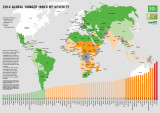Collaborative management of forests
Millions of the rural poor now participate in collaborative forest management schemes under a variety of tenurial and organizational arrangements.We examine those arrangements and ask whether local people have indeed gained more access to benefits from and control over forests. Our findings suggest that most co-management projects actually maintain and even extend central government control. -- from Text.
Equilibrio del desarrollo agropecuario y la deforestación en la Amazonia Brasileña
This report identifies the links among economic growth, poverty alleviation, and natural resource degradation in Brazil. It examines the effects of (1) a major devaluation of the Brazilian real (R$); (2) improvements of infrastructure in the Amazon to link it with the rest of Brazil and bordering countries; (3) modification of land tenure regimes in the Amazon agricultural frontier; (4) adoption of technological change in agriculture both inside and outside the Amazon; and (5) fiscal mechanisms to reduce deforestation." -- from Author's Abstract
Synopse Welthunger-Index 2014: Herausforderung verborgener Hunger
Der Welthunger-Index (WHI) 2014 stellt die nationale, regionale und weltweite Hungersituation zum neunten Mal in jahrlicher Folge multidimensional dar. Er zeigt, dass bei der globalen Hungerbekampfung seit 1990 Fortschritte erzielt werden konnten, jedoch angesichts sehr ernster oder gar gravierender Hungerwerte in 16 Landern noch immer groser Handlungsbedarf besteht. Der Schwerpunkt dieses Berichts liegt auf einem entscheidenden Aspekt des Hungers, der haufig ubersehen wird, dem verborgenen Hunger.
Acción colectiva y derechos de propiedad para el desarrollo sostenible
Las instituciones de acción colectiva y los sistemas de derechos de propiedad moldean la forma en que la gente usa los recursos naturales.A su vez, estos patrones de uso afectan los resultados de los sistemas de producción agrícola de la gente. Juntos, los mecanismos de acción colectiva y los sistemas de derechos de propiedad definen los incentivos a los que la gente accede por llevar a cabo estrategias de gestión sostenible y productiva, y afectan el nivel y distribución de los beneficios de los recursos naturales.
2014 Global hunger index by severity
The Global Hunger Index (GHI) is based on three equally weighted indicators: > Undernourishment: the proportion of undernourished people as a percentage of the population (reflecting the share of the population with insufficient caloric intake); > Child underweight: the proportion of children younger than age five who are underweight (that is, have low weight for their age, reflecting wasting, stunted growth, or both), which is one indicator of child undernutrition; and > Child mortality: the mortality rate of children younger than age five (partially reflecting the fatal synergy o
Synthèse l’Indice de la faim dans le monde 2014: Le défi de la faim invisible
Le rapport de l’Indice de la faim dans le monde 2014 – neuvieme edition – propose une mesure multidimensionnelle de la faim au niveau national, regional et mondial. Le GHI 2014 montre les progres effectues en matiere de reduction de la faim depuis 1990, mais des efforts restent a faire, le niveau de la faim restant alarmant voire extremement alarmant dans 16 pays. Cette annee, le GHI se concentre sur un aspect particulier de la faim souvent neglige : la faim invisible.
2014-2015 Global food policy report
This 2014–2015 Global Food Policy Report is the fourth in an annual series that provides a comprehensive overview of major food policy developments and events. In this report, distinguished researchers, policymakers, and practitioners review what happened in food policy in 2014 at the global, regional, and national levels, and—supported by the latest knowledge and research—explain why. This year’s report is the first to also look forward a year, offering analysis of the potential opportunities and challenges that we will face in achieving food and nutrition security in 2015.
Linkages between poverty and land management in rural Uganda
This study investigates the impacts of rural poverty on farmers’ land management decisions, crop production and incomes, based upon analysis of data from the 1999/2000 Uganda National Household Survey.
The Phnom Penh survey: A study on urban poor settlements in Phnom Penh
The report of a 2013 survey conducted to update previous research on urban poor settlements in the Phnom Penh and produce current maps of their locations. This report summarises the data collected, and provides analysis and recommendations for key stakeholders intended to help lead to positive outcomes for the urban poor. The study found 340 urban poor settlements in Phnom Penh. The research shows that the trend of a decreasing percentage of settlements in the inner Khans and a corresponding increase in outer Khan settlements has continued.
Unusual partnerships: Lessons for landscapes and livelihoods from the Doe Mae Salong landscape, Thailand
This paper describes the interventions undertaken in the Doe Mao Salong watershed in an effort to restore the landscape and improve the livelihoods of local communities. Interventions included forming multi-stakeholder platforms to facilitate dialogue and to ensure participatory land-use planning; the creation of tree nurseries for forest rehabilitation; identifying products for sale in local markets; and a focus on action learning. Land-tenure arrangements proved key to these interventions. The report describes the impacts.











